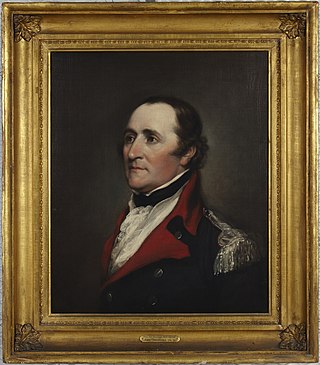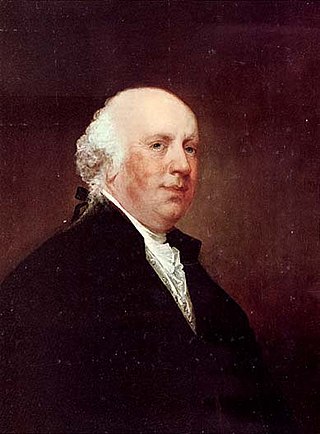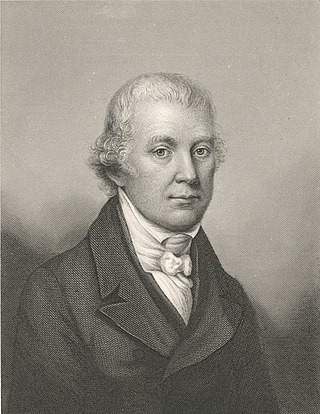
James Mitchell Varnum was an American legislator, lawyer, general in the Continental Army, and a pioneer to the Ohio Country.
The 16th Massachusetts Regiment, also known as Henry Jackson's Additional Continental Regiment, was a unit of the American Massachusetts Line, raised on January 12, 1777, under Colonel Henry Jackson at Boston, Massachusetts. The regiment would see action at the Battle of Monmouth and the Battle of Rhode Island. The regiment was disbanded on January 1, 1781, at New Windsor, New York.

The 1st Rhode Island Regiment was a regiment in the Continental Army raised in Rhode Island during the American Revolutionary War (1775–83). It was one of the few units in the Continental Army to serve through the entire war, from the siege of Boston to the disbanding of the Continental Army on November 3, 1783.

The 2nd Rhode Island Regiment was authorized on 6 May 1775 under Colonel Daniel Hitchcock in the Rhode Island Army of Observation and was organized on 8 May 1775 as eight companies of volunteers from Providence County of the colony of Rhode Island. As part of a brigade organized under Nathanael Greene, the unit participated in the Siege of Boston during the remainder of 1775. Some elements accompanied Benedict Arnold's expedition to Quebec late in the year. The unit was renamed the 11th Continental Regiment on the first day of 1776.

The 9th Connecticut Regiment was a regiment of the Continental Army during the American Revolutionary War. It was first called Webb's Additional Continental Regiment before being added to the Connecticut Line in 1780. It saw action at Setauket in 1777, Rhode Island in 1778, and Springfield, New Jersey, in 1780, and was generally active in the defense of Connecticut, southern New York, and northern New Jersey. It was merged into the reorganized 2nd Connecticut Regiment in January 1781.

The Connecticut Line was a formation within the Continental Army. The term "Connecticut Line" referred to the quota of numbered infantry regiments assigned to Connecticut at various times by the Continental Congress, the size of its allocation determined by the size of its population relative to that of other states. These, together with similarly apportioned contingents from the other twelve states, formed the Continental Line. The concept was particularly important in relation to the promotion of commissioned officers. Officers of the Continental Army below the rank of brigadier general were ordinarily ineligible for promotion except in the line of their own state.

The New Hampshire Line was a formation in the Continental Army. The term "New Hampshire Line" referred to the quota of numbered infantry regiments assigned to New Hampshire at various times by the Continental Congress. These, along with similar contingents from the other twelve states, formed the Continental Line. For the promotion of senior officials, this concept is particularly important. Officers of the Continental Army below the rank of brigadier general were ordinarily ineligible for promotion except in the line of their own state.

The Rhode Island Line was a formation within the Continental Army. The term "Rhode Island Line" referred to the quota of numbered infantry regiments assigned to Rhode Island at various times by the Continental Congress. These, together with similar contingents from the other twelve states, formed the Continental Line. The concept was particularly important in relation to the promotion of commissioned officers. Officers of the Continental Army below the rank of brigadier general were ordinarily ineligible for promotion except in the line of their own state.

Ebenezer Huntington was an officer in the Continental Army during the American Revolutionary War, and afterwards United States Representative from Connecticut.
Israel Angell was a Continental Army officer of the American Revolutionary War.

Henry Jackson was a Continental Army officer from Boston, Province of Massachusetts Bay, during the American Revolutionary War. For most of the war, he was colonel of Jackson's Additional Continental Regiment, which was redesignated the 16th Massachusetts in 1780. He commanded the last regiment of the Continental Army, the 1st American, which was disbanded in 1784. Jackson was a lifelong friend of Henry Knox, another Continental Army officer, whose business affairs he was also heavily involved in.

Christopher Greene was an American legislator and soldier. He led the spirited defense of Fort Mercer in the 1777 Battle of Red Bank, and for leading the African American 1st Rhode Island Regiment during the American Revolutionary War, most notably with distinction in the 1778 Battle of Rhode Island. He was killed in May 1781 at the Battle of Pine's Bridge by Loyalists, possibly because he was known to lead African American troops.

Samuel Ward Jr. was an American Revolutionary War soldier, politician, and delegate to the secessionist Hartford Convention.
Jeremiah Olney was born into an old family from Rhode Island. He formed a company of infantry from that state at the start of the American Revolutionary War. After serving as captain in 1776, he was promoted to lieutenant colonel at the beginning of 1777. As second-in-command of the 2nd Rhode Island Regiment, he fought at Red Bank. After its commander was wounded early in the action, he led Varnum's brigade in bitter fighting at Monmouth in June 1778.

Sherburne's Additional Continental Regiment was a unit of the Continental Army which served from January 1, 1777, until it was disbanded on January 1, 1781. It was commanded by Colonel Henry Sherburne.

Thomas Hunt (1754—1808) was an American military officer who served in the Continental Army during the American Revolutionary War and later served in the United States Army where he rose to the rank of colonel and served until his death.

Colonel Jacob Kingsbury (1756–1837) was a career officer in the United States Army. He was one of the few U.S. Army officers who was a veteran of both the American Revolution and the War of 1812. He was a Federalist.
Church's Regiment was a unit of the Continental Army raised in Rhode Island which served from May 3, 1775 to December 31, 1775 in the American Revolutionary War.
Richmond's Regiment was a regiment formed by the state of Rhode Island in November 1775, during the American Revolution for the defense of the state against an attack by the British.
Babcock's/Lippitt's Regiment was a regiment raised for the defense of Rhode Island during the American Revolution.











